
|
|

October 28, 2005
KFBK 1530, Sacramento, California
By SCOTT FYBUSH
We've finally worked our way through most of the nifty sites we saw in June on our weeklong swing through New England, so beginning this week we'll turn our attention to the opposite coast, as we recap some of the highlights of a late-July visit to northern California, our first visit there in several years.
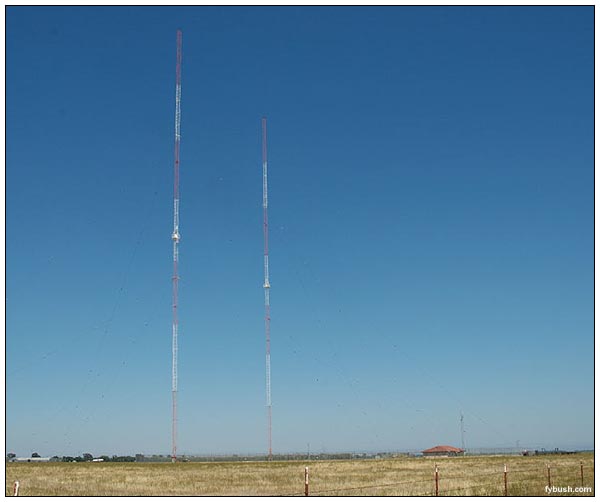
One of the highlights of that trip - possibly the highlight (with no offense intended to Uncle Jacques' 70th birthday celebration, which was also mighty nice) - came at the start of a two-day excursion into the Central Valley, away from the cool bay breezes and into the sweltering summer heat.
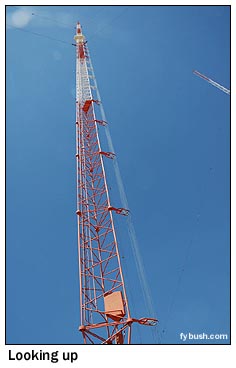
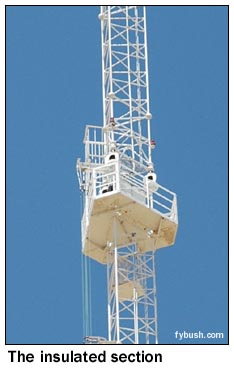 It
was there, amidst the farmland that surrounds Highway 99 in Sutter
County, 25 miles north of downtown Sacramento, that your editor
finally came face-to-face (camera-to-steel?) with the only true
Franklin antenna system in use in the United States.
It
was there, amidst the farmland that surrounds Highway 99 in Sutter
County, 25 miles north of downtown Sacramento, that your editor
finally came face-to-face (camera-to-steel?) with the only true
Franklin antenna system in use in the United States.
This is KFBK, since 1948 the 50,000-watt clear channel voice of Sacramento, and on this hundred-degree day we're treated to a comprehensive tour from Dr. Ross duClair, KFBK's chief engineer.
First, of course, the history:
After an abortive start on Feb. 2, 1922 as KVQ, owned by J.C. Hobrecht, then a brief stint under the ownership of the Sacramento Union and the Kimball-Upson Music Store, KFBK spent most of its life as the flagship station of the McClatchy media empire, which was built on the Bee newspapers in Sacramento, Modesto and Fresno.
Sacramento was a fairly small town then, and as its only station, KFBK wasn't under tremendous pressure to boost power right away. As late as 1934, the station was operating from the Bee building with just 100 watts on the local channel of 1310 kc, but a few years later it was on the (then) clear channel of 1490 kc, sharing the frequency with WCKY in Cincinnati. By 1939, KFBK was running 10,000 watts (I'm not sure from where), and in 1941 it had come to rest on 1530.
This site, and its two 662-foot towers, came into being in 1948, when KFBK finally got its 50,000-watt construction permit. The need to protect WCKY more or less dictated the transmitter site far to the north of town: from here, KFBK can send its signal north and south by day, tucking in the pattern to a tighter figure-eight at night, when the eastern null towards Cincinnati falls over a relatively unpopulated part of the Sierra Nevadas. (WCKY, as the original class I station on the channel, gets to stay on its daytime non-directional antenna until Sacramento sunset.)
The tradeoff to the tight null is a massive signal in KFBK's north and south lobes, made all the more massive by the unusual configuration of the Franklin antennas.
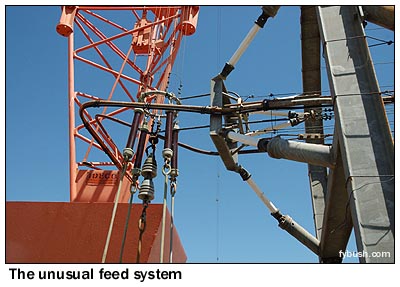 |
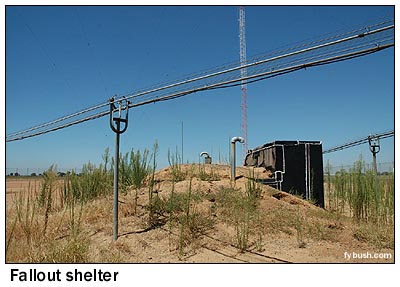 |
A Franklin, strictly defined, consists of two 180-degree antennas separated by an insulator, stacked vertically and fed at the center. By that strict definition, these are the only Franklins in the U.S. (KSTP in St. Paul, Minnesota has two 179-degree stacked segments, and shorter segmented antennas are or have been used at several other stations, including KNBR in San Francisco, which we saw in last week's installment, WHO in Des Moines, KDKA in Pittsburgh, WNBF in Binghamton and WNBC/WCBS in New York.)
What a Franklin does, in exchange for the cost of building and maintaining such a massive structure, is to provide massive signal efficiency, and thus massive groundwave signal strength. According to the FCC, KFBK puts out 3545.89 mV/m, which happens to be the highest field strength of any U.S. AM station. The payoff of all that groundwave strength, coupled with the low radiation angle from the towers, is a resistance to skywave fading that most stations would envy.
(And I should note at this point that I'm a history major, not a trained engineer, so there will no doubt be some corrections forthcoming from the usual engineering suspects.)
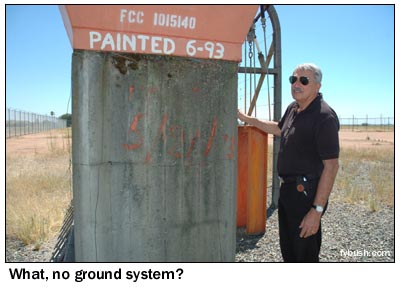 |
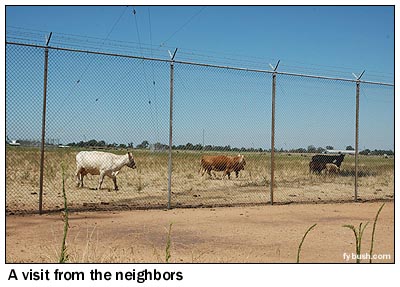 |
Enough history and engineering theory - let's look at these towers, shall we?
Walking back to the towers from the transmitter building, the first thing Ross points out is the bomb shelter that protrudes from a mound of dirt out back. The next thing - and the most obvious feature here, aside from the towers - is the open-wire feed out to each tower, the last (quarter-wave) section of which is enclosed in a "bazooka" cage that serves to match the impedance of the line to the tower. At the end of the bazooka, a complicated net of insulators and springs takes the open line through a 90-degree turn and up a series of standoffs to the matching point up at the midpoint of the tower.
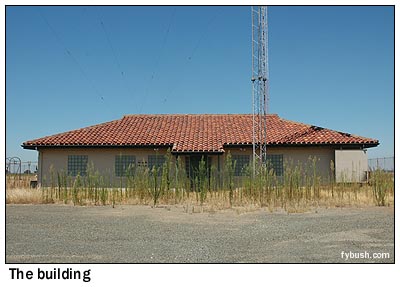 (Check
out the view of that feed system above - and note the "Ideco"
plate at the base of the tower itself. That tower - the west
one - is the original one, from 1947; the east tower was hit
by a plane in the sixties and subsequently rebuilt.)
(Check
out the view of that feed system above - and note the "Ideco"
plate at the base of the tower itself. That tower - the west
one - is the original one, from 1947; the east tower was hit
by a plane in the sixties and subsequently rebuilt.)
Another bit of weirdness here: because the Franklin antenna is essentially a big dipole, it doesn't need a ground system, the way a conventional antenna system would. There's no heavy strapping coming down from the bottom of this tower, just a few vestigial wires, as much for show as for anything else. This, says Ross, has confused the heck out of at least one FCC inspector over the years...
That unusual cone-thingy that surrounds the tower base? That keeps the insulators from being shot out.
And we should note that there's not likely to be a NIMBY problem here: the only neighbors are the bovine ones basking in the RF just outside the fence.We could stare at these towers all day - if it weren't, as previously noted, something like 100 degrees outside. (But it's a dry heat...or at least that's the local excuse.)
Let's head inside, then, through the back door of this structure, built more like a low-slung ranch dwelling than like the big Art Deco palaces so many other 50 kilowatters were putting up around the same time.
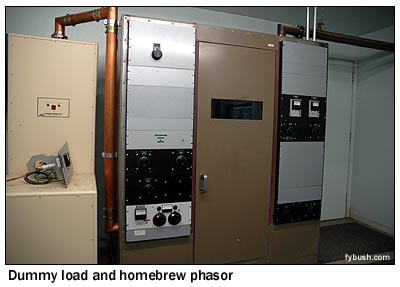 |
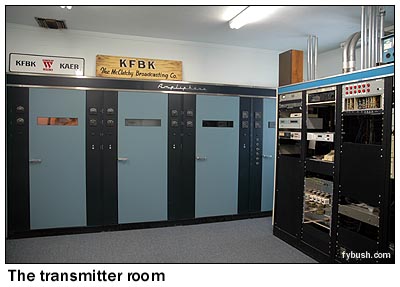 |
Right next to the door is the phasor, built in-house by the McClatchy engineers way back when. These were - as we'll see in an upcoming Site of the Week, in even greater detail - some very talented folks, designing and building much of their own gear right here in central California.
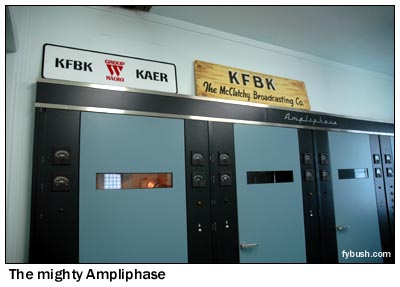
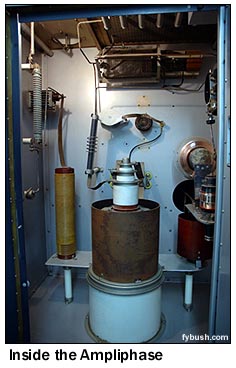 It's
not just the phasor, mind you: if you believe the local legend,
the McClatchy engineers were also the original designers of the
Ampliphase transmitter that graces the transmitter room in the
front of the building - or at least, they were the ones who adapted
a French design, built a working version, and then sold the result
to RCA.
It's
not just the phasor, mind you: if you believe the local legend,
the McClatchy engineers were also the original designers of the
Ampliphase transmitter that graces the transmitter room in the
front of the building - or at least, they were the ones who adapted
a French design, built a working version, and then sold the result
to RCA.
In any case, that's most definitely an RCA BTA50-H1S transmitter sitting there, and yes, it still runs. I'm told it sounds great, too. (And no, I'm not even going to try to stretch my history-major understanding of transmitter design theory to explain how an Ampliphase transmitter works; there are some much better descriptions than I can offer out there for your Googling pleasure.)
Atop the Ampliphase sit a few more chapters of KFBK's history: under McClatchy, the station became the flagship of a broadcasting empire that stretched the length of central California, including KFBK-FM in Sacramento, KWG radio and KOVR(TV) in Stockton, KMJ radio/TV in Fresno and beyond.
Over the years, the empire was divided up, with KFBK and KAER (the former KFBK-FM) becoming Group W stations in the early eighties. Under Westinghouse ownership (which later passed to a brand-new company called Chancellor Media in 1994, which morphed into AMFM and then into today's Clear Channel, the station's current owner), the Ampliphase got some company out here: the very first example of a new transmitter from the folks at Harris.
 |
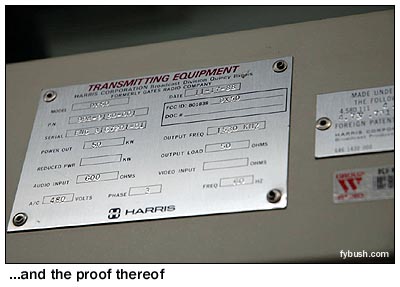 |
Note the date on the manufacturer plate on the back of this particular DX50: 11-17-88, which makes this box truly one-of-a-kind. Ross says whenever the need arises to call Quincy for service tips, the Harris folks have to pull out a special set of manuals and drawings that are unique to this prototype model of what would later become the most popular transmitter for 50 kW use in the U.S.
The DX50, still the main transmitter, sits in a little alcove toward the rear of the building, to the left of the Ampliphase.
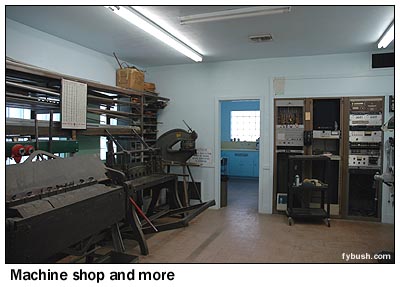 |
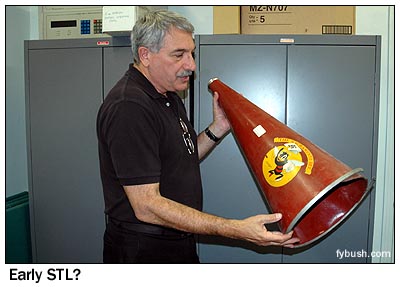 |
A rack of STL gear sits to the right of the Ampliphase, along the front wall of the building. In the next room, illuminated by the glass-block windows on the front wall of the building, sits a wonderful old machine shop and KFBK's audio processing. From there, we continue into a sunny kitchen area, and from there back toward the rear of the building, where several rooms are filled with older studio equipment that's now in retirement.
There's one more nifty bit of history that deserves to be shown off here: that megaphone. Why is it called the "Mickey Phone"? Check out that bee logo, an rare piece of contract work done by a commercial artist named Walt Disney for McClatchy's Bee newspapers. (And no, there is no truth to the rumor that Telos is about to put these back into commercial production...)
Magnificent site, isn't it? Yet it's just a part of the impressive broadcast scene here in the Sacramento area. Stay tuned for much more (and much taller) in the next few weeks...
JUST RELEASED - it's your very first chance to order the 2006 Tower Site Calendar! Click here for ordering information!
- Previous Site of the Week: KNBR, KSCO and KMBY
- Next Week: More Sacramento AMs (and a few FMs, too)
- Site of the Week INDEX!
- How can you help support Site of the Week? Click here!
- Submit your suggestions for a future Site of the Week!
